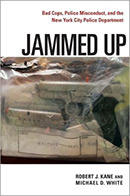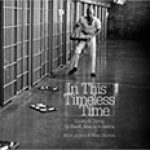Jammed Up: Bad Cops, Police Misconduct, and the New York City
Police Department

Authors: Robert J. Kane and Michael D. White
Publisher: New York: New York University Press, 2013. 220p.
Reviewer: Robert Costello | March 2013
Last November 14th was an unseasonably cold night in New York City with temperatures in the low 30s. New York Police Officer Lawrence DePrimo was assigned to a special Midtown detail and was on routine foot patrol when he encountered at 7th Avenue and 44th Street Jeffrey Hillman–a homeless man with no shoes or socks. When the barefooted man explained he never owned any shoes, Officer DePrimo, a three year veteran of the New York Police Department (NYPD) who earns $48,000 per year, spent $50 of his own money to purchase a pair of boots and two pairs of wool socks. A tourist snapped a picture of Officer DePrimo giving Mr. Hillman the boots and socks – a picture that has been viewed over 1.6 million times across the world thanks to social media outlets. This heartwarming story is the exact opposite of the picture presented in Jammed Up – as witness the following:
In December 2008, a New York City cab driver called 911 to report an intoxicated female passenger who vomited in his taxi and was unable to pay the fare. Two New York Police Officers responded and helped the woman by taking her inside her apartment. Security cameras in the woman’s building showed the officers returning four times that night even though she never requested further help from the police. After an investigation, the officers were charged with rape, burglary, and official misconduct, but were ultimately found guilty only of the official misconduct and were terminated by the NYPD.
The term “jammed up” is NYPD jargon for when the department “launches an investigation into alleged misconduct either administrative or criminal” (p. 6). Within the NYPD, supervisors who represent the formal department organization, citizens who file official complaints, and the Civilian Complaint Review Board (CCRB) all have the power to jam up police officers. The foundation of this insightful book is traced to a 1996 National Institute of Justice (NIJ) funded study called Bad Cops; a study that first author Robert J. Kane assisted the late James J. Fyfe in carrying out. In particular, that study “sought to explore the nature and prevalence of police misconduct in the NYPD from 1975 to 1996, as well to identify relevant personal and career history characteristics most responsible for distinguishing between officers who engage in career-ending misconduct and officers who did not” (p. 3).
Bad Cops may be the largest study of police misconduct in the United States, and without any model or precedent to follow it became a methodological challenge of which the authors of this book provide an excellent overview. In 1996 the NYPD had no central file or database regarding employment separations. Consequently, the researchers had to review the “Personnel Orders” which reported weekly every change in employment status within the NYPD and were disseminated to every departmental unit. This step yielded an original pool of 3,000 police officers whose misconduct resulted in their police career ending. The researchers reviewed the personnel files of these 3,000 officers. These files provided contextual data about the officers including the lengthy NYPD employment application, performance appraisals during the police academy, annual job performance evaluations, reports of disciplinary actions, sick leave, and injuries. Lastly, the researchers accessed a computer database system that captured all “critical career events” that involved either the Internal Affairs Bureau and/or the Department Advocate, who is the NYPD prosecutor for cases with serious infractions.
Jammed Up was framed by the following two research questions:
- What was the nature and prevalence of organizational misconduct during this 22-year (1975-1996) period that included a fairly complete cycle of scandal and reform?
- What were the relevant personal and career history characteristics most responsible for distinguishing between officers who engaged in career-ending misconduct and officers who did not?
The authors address these questions over the course of 8 chapters. Not only is the book extremely well researched and complete with references and citations of the scientific literature pertaining to police misconduct studies, but the writing style is accessible to a general audience as it uses a character-driven model of police misconduct cases and examples. Furthermore, Kane and White must be commended for the format of each chapter which covers one or two key aspects of police misconduct following a logical and coherent build-up until the research questions are answered. It is important to note that the book is applicable to all police misconduct, and is not limited to the NYPD. The authors engage in a generalized conversation about this serious issue and how “good” policing can arise from it.
Chapter 1 serves as an introduction to the subject of police misconduct as it defines the term “jammed up,” with interesting real cases that highlight the ambiguity of police misconduct which Chapters 2 and 4 then adeptly cover by respectively developing a definition and classification system for misconduct. The defining and measuring of police misconduct, its prevalence, and what empirical evidence there is on its causes are explored in the second chapter. After careful review of several existing definitions of police misconduct, the authors show how each one has its limitations and problems. While there is consensus on the key elements for the major forms of misconduct, this agreement disappears when certain specifics pertaining to the officer’s action are introduced into a scenario. These include: officer is off-duty; the misdeed violates departmental policy but is not criminal; and the misdeed is the result of carelessness and not malice, as just a few examples where there is not consensus. The absence of a universal definition for police misconduct leads to the inability to estimate its prevalence. In addition, the lack of a national central database for police misconduct makes it extremely difficult to measure its frequency.
Kane and White describe the outside influences on the NYPD as well as critical historical events such as the social, political and financial health of the City during the 22 year period examined, thus helping to understand police misconduct. For example, the fiscal crisis facing New York City from 1975-1979 resulted in 5,000 police officers being laid off. During this period, the NYPD was so strapped for personnel that very few officers were terminated due to misconduct. Once the fiscal clouds passed, the NYPD engaged in a massive hiring spree from 1980-1984; hiring that occurred so rapidly that proper vetting of applicants was not conducted, leading to many becoming problem officers with misconduct charges.
The authors find that the NYPD employed 78,000 officers in the 22 year period of 1975 to 1996, with 1,543 being separated for career-ending misconduct, or roughly 2%. That misconduct was classified into the following categories: administrative/failure to perform (30.1%), drugs (19%), profit-motivated crime (15.7%), off-duty crime against persons (11.6%), off-duty public order crimes (5.8%), on-duty abuse (4.8%), and conduct while in the first year of service [known as probationary period] (2.2%). The personal characteristics of the separated officers, as compared to those officers who served honorably, included lower educational attainment, being younger, being more likely to have performed poorly in the police academy, having more citizen complaints, being more likely to have poor prior employment histories, being more likely to be divorced/separated and with children, and being more likely to be a minority.
The second half of the book moves beyond the NYPD and transitions from the causes and consequences of “bad” policing to a fuller discussion of how the lessons from this study can lead to “good” policing. While Kane and White generally employ an accessible writing style, Chapter 5 may be a challenge for those without an above average understanding of statistical analysis in that they report on the use of a multivariate technique to examine the individual-level predictors of police misconduct. They follow by examining and critiquing crime fighting strategies used by police departments to show how overly aggressive policing may lead to police misconduct especially in the form of police violence. Potential explanations for police misconduct are then discussed in Chapter 7 by applying various criminological theories – especially Strain and Social Learning theories — with a discussion on both the potential and limitations of such an examination. Finally, they conclude with a model of good policing, describe the shortcomings of the particular study they present, and offer grounds for future work in the area.
The NYPD Academy graduated 1,000 new police officers in late 2012, and one wonders how much time is devoted to police misconduct in the academy curriculum. Just as “Broken Windows Theory” impacted police tactics and is credited with crime reduction, I hope law enforcement officials begin to utilize other works like this seminal book to help to continuously improve policing in our country.
Robert Costello, JD, Ed.D., Associate Professor & Chair, Criminal Justice Department, SUNY Nassau Community College and Adjunct Associate Professor, Sociology Department, Hofstra University


